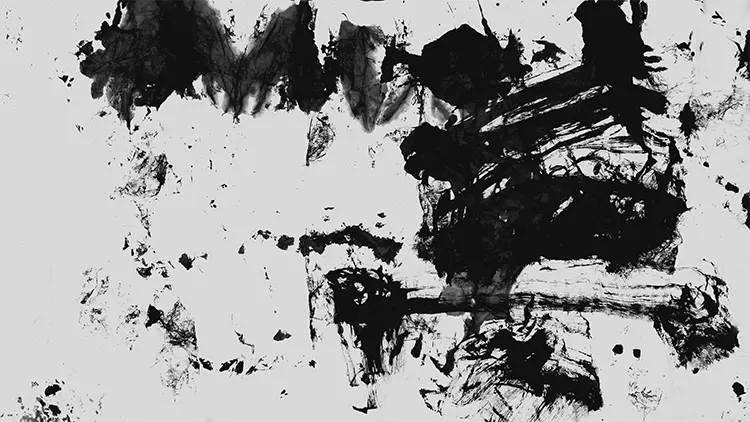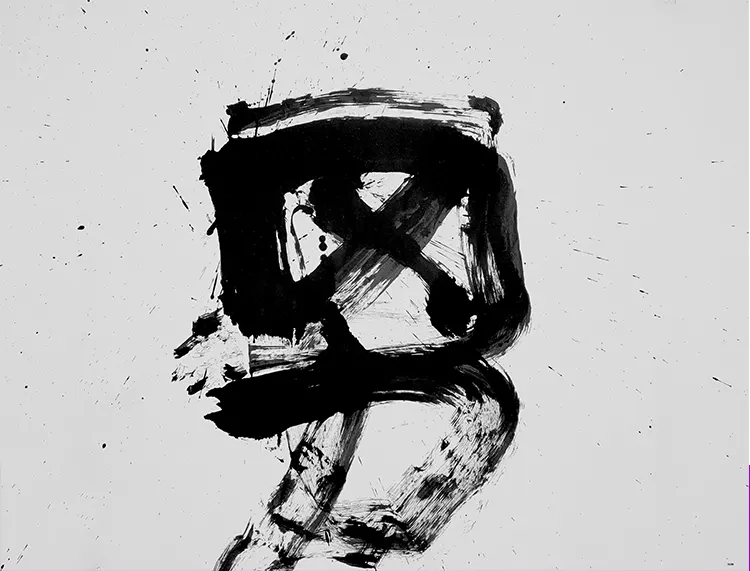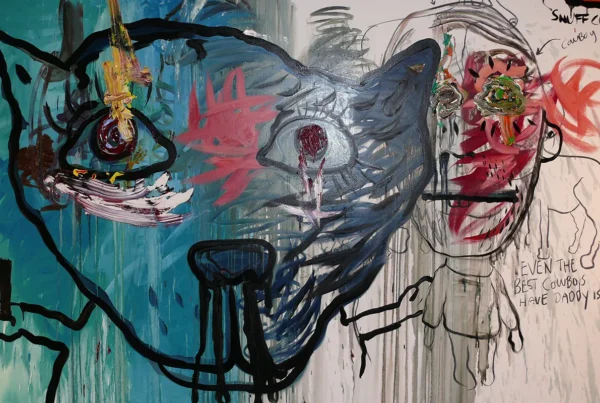“Even after I leave this world, hundreds of years from now, I want to impress people of that era with my work. That is my dream. “
The Calligraphic Journey of Hiroshi Wada
Hiroshi Wada is a calligraphy artist based in the culturally vibrant city of Kyoto, Japan. His creative journey commenced from a young age, engaging with the traditional practice of Japanese Shodo, a term directly translating to ‘the way of calligraphy’, from the tender age of five. This early exposure to the artistic discipline contributed to Wada’s development of a deep and abiding passion for the art form.
Embarking upon a more rigorous study in his 30s, Wada sought the tutelage of Ryosetsu Imai, a recognized master in the world of calligraphy. Under Imai’s watchful guidance, Wada’s understanding and skill in the art form evolved and matured, his technique becoming more refined and his artistic voice more distinct. It was during this period that Wada found his works garnering recognition, achieving the significant milestone of selection for the Nitten exhibition, considered the most prestigious and expansive general art exhibition in Japan.
In his current phase, Wada has made strides beyond the confines of Japan, exposing his work to a more global audience. His calligraphic pieces have found a home in diverse locales, as he frequently exhibits his work in both solo and group exhibitions primarily across the United States and Europe. With his compelling portfolio, Wada continues to captivate audiences and contributes to the global understanding and appreciation of the nuanced art of Japanese calligraphy.

Artistic Influences Shaping Hiroshi Wada’s Work
Since his earliest days, Hiroshi Wada has been captivated by the artistry of words. The act of committing thoughts and feelings to paper through a melange of unique strokes and swirls had been an integral part of his life even in his early childhood. From the tender age of five, Wada had been immersing himself in the study and practice of Japanese calligraphy, a dedication that has spanned over half a century, rendering the practice as inherent to him as breathing itself. The belief that he was destined to inhabit the world of art has been a profound and unwavering conviction in Wada’s life.
The artistic influences that have shaped Wada’s work are diverse and impactful, contributing to the richness and depth of his oeuvre. Figures like Ryosetsu Imai, his Japanese mentor, have left a lasting imprint on his style. The influence of Yuichi Inoue, another venerable master in the field, is discernible in his work. Moreover, the influence of the West is not lost on Wada; the stylistic leanings of Franz Kline, an American artist, can be identified in his work, creating a nuanced blend of Eastern and Western influences.
The distinctive oeuvre of Wada emerges from his skillful application of Japanese calligraphy techniques. His work, while being firmly rooted in this tradition, diverges from the beaten path, eschewing the creation of classic calligraphy. Instead, Wada’s focus is on the “art of lines”, a fascinating exploration that seeks to distill and elevate the essence of traditional calligraphy to a contemporary visual language that transcends the conventions of his practice.
Each work from Wada’s brush is a testament to the power of serenity, for he believes that tension is the nemesis of creativity. In order to maintain a relaxed state while creating his art, he often invites music into his workspace, creating an ambiance that facilitates the free and unhindered flow of artistic expression. The resulting works are vivid manifestations of Wada’s philosophy and practice, standing as unique testimonies to a life dedicated to the pursuit of artistic exploration and innovation.

Unveiling the Complexity of Hiroshi Wada’s Calligraphy
Hiroshi Wada has dedicated himself exclusively to this traditional form of Japanese art. In the seemingly uncomplicated act of drawing lines, he has found his life’s work, a vocation that might appear straightforward to the untrained eye. However, the creation of a line, pulsating with life and spirit, is a monumental task that goes beyond mere simplicity.
For Wada, this labor of love is the culmination of over five decades of rigorous training in the complex discipline of calligraphy. His extensive experience has allowed him to master the intricate process of drawing lines that teem with life and energy. His work extends beyond two-dimensional boundaries, manifesting in lines that project a tangible depth, evocative of the sinuous branches of a tree. His sharp lines, so exquisitely crafted, seem capable of incising skin, should a finger dare to graze their razor-edged silhouettes.
Wada’s comprehension of the symbiotic relationship between different types of lines is paramount to his work. He orchestrates a fine balance between main lines and supporting lines, establishing a harmonious rhythm and unity. His expertise extends to the ongoing dance between contrasting elements: the tension and interplay between light and dark, the battle between black and white spaces on his canvas, provide a profound resonance that underscores the thematic depth of his pieces.
Perhaps the most enchanting aspect of Wada’s artistic vision is his ability to discover and appreciate the sublime beauty resonating between the lines of his work. Like a musical conductor extracting a symphony from silence, Wada brings forth echoes from the spaces between his lines, creating an ineffable dialogue that transcends the visual aspect of his art. In the minimalistic elegance of his calligraphy, one discovers a world of nuance, depth, and expressive power.

The Transformative Power of Damage in Hiroshi Wada’s Art
Immersed in the intricate artistry of Japanese calligraphy, Hiroshi Wada crafts an aesthetic tapestry that transcends the inherent meaning of the letters he skillfully scribes. However, Wada does not perceive a direct correlation between the semantic value of the characters and the mesmerizing beauty that manifests from their curvilinear forms.
Often, Wada’s masterpieces bear the unmistakable touch of damage, appearing as stains on the canvas. These instances of seemingly accidental damage are intriguingly integral to his work, amalgamating the lines purposefully etched by his own hand. When the delicately rendered lines blend seamlessly with the unintended stains, a resonance, a symphony of visual harmony, is born.
Wada is acutely aware of the fine and intriguing threshold where random damage is on the brink of being dismissed as mere imperfections, only to be miraculously elevated into an integral component of beauty. This precarious balance is where his creations inhabit, showcasing the duality of intended strokes and spontaneous splatters.
The artist’s ambition steadfastly remains in crafting not merely lines but a compelling congregation of strokes that possess the irresistible magnetism to captivate onlookers. It is through his understanding of the transformational power of damage and the beauty of calligraphic strokes that Wada consistently aspires to create works which command a silent, yet potent dialogue with the viewer’s heart.






